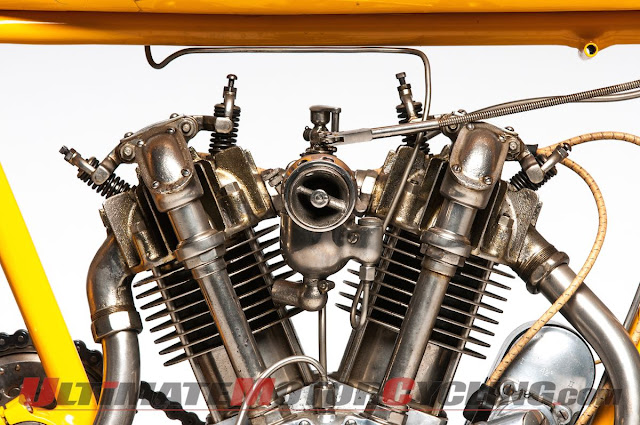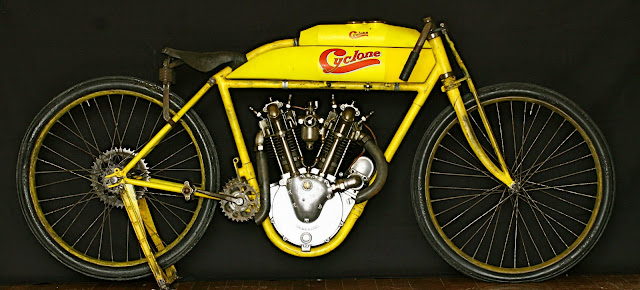Cyclone V-Twin
Cyclone’s overhead camshaft V-twin was by far the most technically advanced motorcycle unit ever seen in America, and was arguably the most powerful engine of its size in the world.
Cyclones were known for their speed, their advanced but not always reliable engine design, and their bright yellow paintwork. The 996cc V-twin engine was held in a U-shaped frame whose top tubes ran above and below the fuel tank.
If Cyclone’s lean and powerful V-twins could have added reliability to their undoubted speed, they might have become a huge success. Built at St. Paul,
Minnesota by the Joems Motor Manufacturing Company, the bikes were produced for only a few years from 1913 but made an impact out of all proportion to their lifespan.
The key to the performance of Cyclone’s 996cc, 45-degree V-twin engine, designed by Andrew Strand, was its single overhead camshaft layout, a rarity at the time. The cams were driven by bevel shaft. Another shaft worked the magneto at the front of the cylinders. The rest of the motor was packed with state-of-the-art engineering: roller bearing crankshaft, lightweight conrods, and forged steel flywheels in a spoked style.
Most roadgoing Cyclones were fitted with leafspring suspension at front and rear, giving reasonable comfort as well as excellent performance. Racing versions generally matched their highly tuned engines with distinctive bright yellow paintwork and no suspension. Other parts such as handlebars were also varied but the tubular steel frame, which held the fuel tank between its twin top tubes, and cradled the engine in its U- shaped main section, was common to both.
 |
During Cyclone’s short life the marque generated a great amount of interest. This was due to the bikes’ speed and technical specification, and also to the hard-riding style of factory pilot Don Johns. He was particularly impressive because, in the fashion of the era, Cyclone’s racing V-twin four-stroke engines were ‘ported’ - vented to the open air through rectangular ports which opened when the pistons neared bottom-dead-centre. The theory was that this increased power by allowing rapid expulsion of exhaust gas, though in fact the boost is now thought to be due to a crude supercharging effect.
The result of porting was that the Cyclones were literally fire-breathing devices, belching smoke, noise and, in night races, blue flames that flickered around the motor and riders’ legs. Porting prevented proper control of intake air, so riders including Johns had to control their speeding bikes using an ignition kill-switch on the handlebar, resulting in spectacular wheelspin on the dirt-tracks and sometimes in big crashes.
Suspiciously fast
Cyclone’s reputation was boosted when in 1913 factory rider JA McNeil lapped the Omaha, Nebraska board track at lll.lmph (178.8km/h), a speed more than lOmph (16km/h) in excess of both the recognized world and American records. So big was this margin that the authorities were suspicious and refused to ratify the achievement.
The factory’s status continued to grow following a string of wins in the 1915 season, although some of these were in second-rate races in Illinois and Ohio. Less welcome was a succession of mechanical problems that would dog Cyclone throughout the marque’s life. The ohc motor’s failings included piston and valve problems. The two-part camshaft drive towers were also reported to have a tendency to stretch and flex at high revs.
Typical of the marque’s fortunes was its experience at the prestigious 300-mile (483km) National championship race at Dodge City, Kansas. Against factory opposition from the 'Big Three’ of Indian, Excelsior and Harley-Davidson, Cyclone rider Dave Kinney qualified fastest, at 88.5mph (142km/h), and Johns led the early stages of the race. But before one-third distance, both Cyclone riders had retired with machine problems.
Johns left to ride for Indian at the end of the season and. although Kinney won some races for Cyclone in 1916. Joems Manufacturing could not sell enough roadsters to pay for further machine development and to hire top quality riders. The Minnesota firm folded at the end of that season.
Roadgoing and racing Cyclones were similar in most respects, the roadster’s most obvious difference being its front and rear leafspring suspension. With comfort to match its performa
Cyclones were produced by the Joems Motor Manufacturing Company of St. Paul, Minnesota. Although built for only four years from 1913, their technology and speed were impressive.
Specification Cyclone V-Twin (1916)
- Engine Air-cooled sohc four-valve 45-degree V-twin
- Capacity 996cc
- Maximum power 25bhp @ 5000rpm
- Transmission Chain final drive
- Frame Steel single downtube
- Suspension Leaf spring front and rear
- Brakes None front; drum rear
- Weight 280lb (127kg)
- Top speed 85mph (137km/h)
















0 comments: